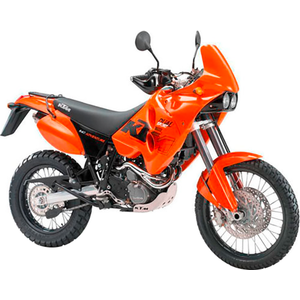KTM 640 LC4 Adventure (2004-2007): The Rugged Single-Cylinder Trailblazer
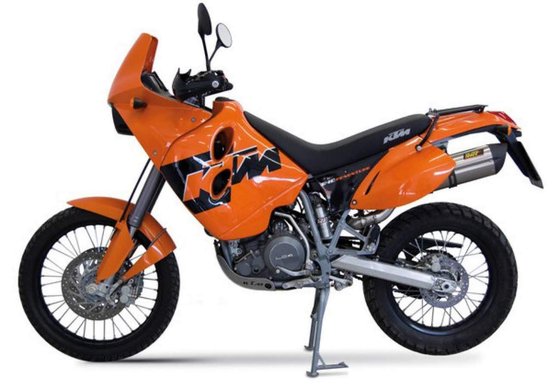
Introduction
The KTM 640 LC4 Adventure stands as a testament to an era when adventure motorcycles prioritized raw capability over creature comforts. Built between 2004 and 2007, this Austrian machine carved its niche as a lightweight, no-nonsense dual-sport bike designed to conquer both trails and tarmac with equal gusto. Unlike modern ADV bikes bloated with electronics and luxury features, the 640 Adventure strips riding down to its essence: a visceral connection between rider, machine, and terrain.
After spending a week with this orange beast—threading through mountain trails, slogging through mud, and even commuting on highways—it’s clear why this generation remains a cult favorite among hardcore adventurers. Let’s dive into what makes this bike tick.
Engine Performance: The Heart of a Workhorse
At the core of the 640 Adventure lies KTM’s legendary LC4 engine—a liquid-cooled, 625cc single-cylinder powerplant churning out 53.6 HP at 7,000 RPM and 55 Nm (40.6 lb-ft) of torque at 5,500 RPM. This isn’t an engine that coddles you with smoothness; it’s a thumper that communicates every combustion cycle through the handlebars and seat.
Key Highlights:
- Carbureted Simplicity: The Mikuni BST 40 carburetor delivers crisp throttle response, though it demands occasional tuning, especially when switching between altitudes.
- Torque for Days: With peak torque arriving early at 5,500 RPM, the bike lunges forward eagerly from idle, making it ideal for technical climbs or hauling gear.
- Vibration Character: At highway speeds (80-120 km/h or 50-75 mph), vibrations are noticeable but never numbing. It’s part of the LC4’s charm—a constant reminder you’re riding a machine built for punishment.
During my test ride, the engine’s versatility shone. On tight forest trails, second and third gears handled everything from root-infested climbs to rocky descents. On pavement, fifth gear cruised comfortably at 110 km/h (68 mph), though the single-cylinder’s growl becomes a roar past 130 km/h (80 mph).
On-Road and Off-Road Handling: A Study in Contrasts
Off-Road Dominance
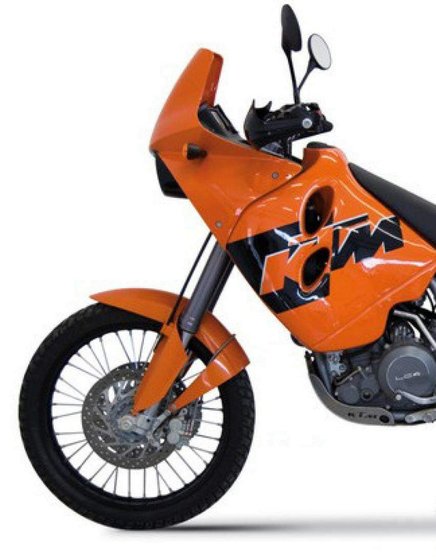
The 640 Adventure’s dirt-biased DNA is evident in its chassis. The 21-inch front wheel and 18-inch rear (shod with knobby tires) float over ruts and rocks, while the WP suspension—300 mm (11.8 in) of travel up front and 320 mm (12.6 in) at the rear—soaks up impacts like a sponge.
Dirt-Riding Takeaways:
- Flickable Weight: At 158 kg (348 lbs) dry, the bike feels nimble in technical sections. Dropping it in mud is a hassle, but picking it up solo is manageable.
- Brake Finesse: The dual 300mm front discs offer strong stopping power, but on loose surfaces, modulation is key. Lock the front wheel on gravel, and you’ll learn humility quickly.
On-Road Manners
Surprisingly, the 640 Adventure doesn’t embarrass itself on asphalt. The steering head angle of 62.5° and wheelbase of 1,510 mm (59.4 in) lend stability at speed, though crosswinds can unsettle the tall profile.
Highway Notes:
- Windblast Woes: The minimalist fairing offers little protection. After an hour at 100 km/h (62 mph), your neck muscles will protest.
- Fuel Range: The 25.5L (6.7 gal) tank delivers ~350 km (217 mi) of mixed riding—enough for remote adventures.
Ergonomics and Comfort: Built for the Long Haul (Sort Of)
The 945 mm (37.2 in) seat height intimidates shorter riders, but the narrow seat profile lets most riders dab a foot at stops. The upright riding position is comfortable for hours, though the foam seat firms up after 90 minutes.
Pro Tip: Swap the stock seat for an aftermarket gel unit (available at MOTOPARTS.store) if planning multi-day trips.
Competition: How Does It Stack Up?
The 640 Adventure’s rivals in the mid-2000s included:
- Honda XR650L:
- Pros: Bulletproof reliability, lower seat height.
- Cons: Air-cooled engine, softer suspension.
-
Verdict: The XR650L is a better commuter; the KTM dominates off-road.
-
Suzuki DR650SE:
- Pros: Lighter, cheaper to maintain.
- Cons: Less power, dated suspension.
-
Verdict: The DR650SE is a jack-of-all-trades; the KTM is a master of dirt.
-
BMW F650GS:
- Pros: Smoother twin-cylinder, better wind protection.
- Cons: Heavier, less ground clearance.
- Verdict: The BMW coddles; the KTM conquers.
Maintenance: Keeping the LC4 Alive
The 640 Adventure rewards those who stay on top of upkeep. Here’s your cheat sheet:
Critical Service Items
- Valve Adjustments: Every 10,000 km (6,200 mi). Intake/Exhaust clearance: 0.12-0.15 mm (0.0047-0.0059 in).
- Oil Changes: Use 20W-60 full synthetic. Capacity: 2.1L (2.2 qt) with filter.
- Chain Care: The 16/42 sprocket combo wears quickly if neglected. Clean and lube every 500 km (310 mi).
Common Upgrades
- Air Filter: Swap the stock foam filter for a high-flow kit to unleash the LC4’s full growl.
- Suspension Tuning: WP forks benefit from heavier SAE 5W oil for aggressive riding.
- Exhaust: The stock HGS system is robust, but aftermarket slip-ons shed weight and amplify the exhaust note.
Conclusion: The Uncompromising Adventurer
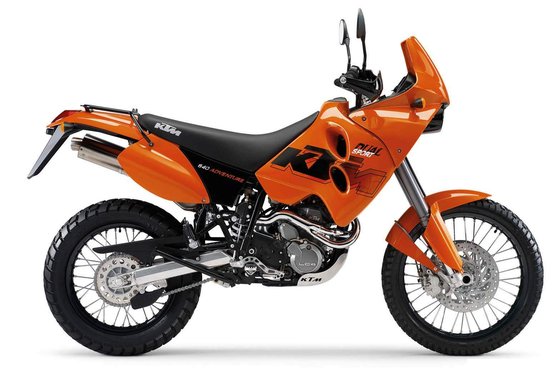
The KTM 640 LC4 Adventure isn’t for everyone. It vibrates, it’s loud, and it demands mechanical sympathy. But for riders who value simplicity, agility, and a direct connection to the ride, few bikes match its character. Whether you’re threading through single-track or chasing horizons on backroads, this KTM reminds you why adventure motorcycling was born in the dirt.
Ready to customize yours? Explore MOTOPARTS.store’s curated selection of LC4-compatible upgrades—from heavy-duty skid plates to ergonomic handlebar kits. Your next adventure deserves nothing less.
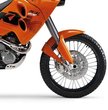

Specifications sheet
| Engine | |
|---|---|
| Stroke: | Four-stroke |
| Ignition: | Kokusan DC-CDI |
| Max power: | 40 kW | 54.0 hp |
| Max torque: | 55 Nm |
| Fuel system: | Mikuni BST 40 carburetor |
| Max power @: | 7000 rpm |
| Displacement: | 625 ccm |
| Max torque @: | 5500 rpm |
| Bore x stroke: | 101 x 78 mm (4.0 x 3.1 in) |
| Configuration: | Single |
| Cooling system: | Liquid |
| Compression ratio: | 11.0:1 |
| Number of cylinders: | 1 |
| Dimensions | |
|---|---|
| Wheelbase: | 1510 mm (59.4 in) |
| Dry weight: | 158 |
| Wet weight: | 185 |
| Seat height: | 945 mm (37.2 in) |
| Ground clearance: | 315 mm (12.4 in) |
| Fuel tank capacity: | 28 L (7.4 US gal) |
| Drivetrain | |
|---|---|
| Final drive: | chain |
| Gear ratios: | 1st 14:35, 2nd 15:24, 3rd 18:21, 4th 20:19, 5th 22:18 |
| Transmission: | 5-speed, claw shifted |
| Rear sprocket: | 40 |
| Front sprocket: | 16 |
| Primary drive ratio: | 30:81 |
| Maintainance | |
|---|---|
| Rear tire: | 140/80-18 |
| Engine oil: | 20W60 |
| Front tire: | 90/90-21 |
| Brake fluid: | DOT 5.1 |
| Spark plugs: | NGK DPR8 EA-9 or NGK DCPR8E |
| Spark plug gap: | 0.6 |
| Coolant capacity: | 1.0 |
| Engine oil capacity: | 2.1 |
| Valve clearance (intake, cold): | 0.12–0.15 mm |
| Valve clearance (exhaust, cold): | 0.12–0.15 mm |
| Recommended tire pressure (rear): | 2.0 bar (29 psi) normal, 2.2 bar (32 psi) loaded |
| Recommended tire pressure (front): | 1.8 bar (26 psi) normal, 2.0 bar (29 psi) loaded |
| Chassis and Suspension | |
|---|---|
| Frame: | Chromium-molybdenum steel |
| Trail: | 124 mm (4.9 in) |
| Rear brakes: | Single 220 mm disc, 1-piston caliper |
| Front brakes: | 2 x 300 mm discs, 2-piston calipers |
| Rear suspension: | WP monoshock |
| Front suspension: | 48 mm WP USD forks |
| Rake (fork angle): | 27.5° |
| Rear wheel travel: | 320 mm (12.6 in) |
| Front wheel travel: | 300 mm (11.8 in) |



